RENEGADE GARDENER™
The lone voice of horticultural reason
Sucked in by SUCCULENTS
These versatile, easy-care plants are prepped to be the trendsetters of 2015
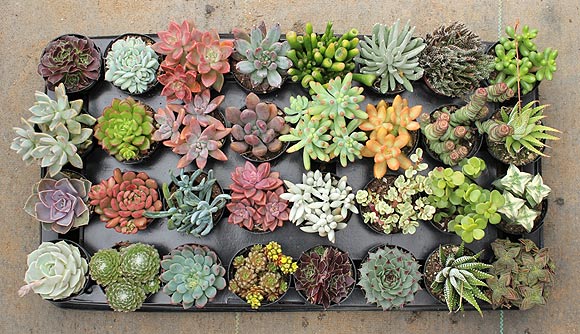
03-01-15 – I’ve come across three articles in the past week, two in nursery trade publications and one in a popular gardening magazine, each stating the same thing: Succulents are set to be the new “it” plant for the upcoming gardening season.
It’s easy to understand why: Succulents are drought-resistant, easy to grow and relatively trouble-free (once you get the soil right). Annual and perennial succulent plants are as at home in the garden bed as in containers, in addition to their value as easy-care houseplants. Certainly, they’re not currently underappreciated (or under-used) across certain regions of the country – the Southwest and Pacific Northwest come to mind – but for most of the rest of us rubes, the nursery table space devoted to succulents come spring is going to be an enlightening delight.
 |
| Succulents are identified by their thick, fleshy stems and leaves. This is genus Crassula ovata (jade plant). |
A definition is in order. Plants are categorized as “succulent” if certain parts of the plant – stems, leaves, or often both – are thicker, or fleshy, compared to non-succulent plants. Leaves noticeably appear thick or puffy, as if retaining water (which indeed they are), such that grasping a leaf between thumb and forefinger feels more like pinching one’s nose or earlobe than a piece of soft paper.
Succulents bloom, though some have indistinguishable flowers, a few have ugly (and/or stinky) flowers, and some don’t seem to bloom at all (except they do, even if it’s only the tips changing color). Some have gorgeous blooms, particularly a large number of cacti.
All genera and varieties of cactus are included in the succulent category. While many succulents are considered annuals, remember, most plants that are called annuals in USDA Zone 4 (or Zone 7) are perennials somewhere. A majority of succulents grown in outdoor containers or garden beds in USDA Zones 3 through 5 are going to need to come inside in winter or be tossed in the compost bin, although you’ll find some, notably several Yucca varieties as well as true cactus varieties, that are hardy to Zone 4 and can remain in the ground in winter.
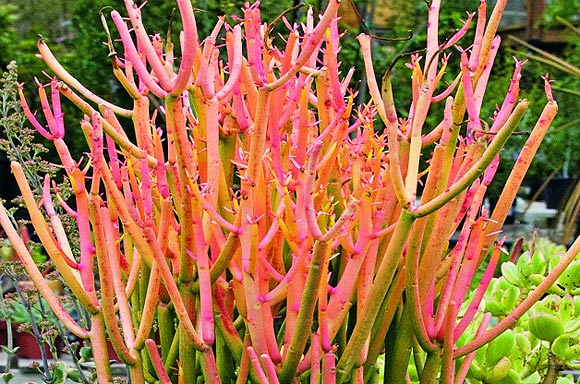 |
| Euphorbia tirucalli (Sticks on Fire) in bloom. |
In general, you’ll be surprised; check succulent nurseries online and the number of plants with good winter cold tolerance that are hardy to zones 4, 5 and 6 will surprise you.
Uses in Containers
 |
| Here’s a foliage bowl I made for the audience last week during a container design class. In the center is the succulent plant Echeveria. |
Succulents in containers are fabulous, adding a strong form and foliage element to a container otherwise housing traditional blooming plants; in combination with other succulents to create a succulent container (oh boy, break out your terra cotta bowls), or as singles in small to mid-sized containers, depending on size of the plant.
In my article, Crafting Cool & Creative Containers I mention the importance of using strong foliage plants in any container housing three or more plants, at a ratio of one foliage plant for every two blooming plants. Well, succulents should be included on the list of strong foliage plants you’ll see this spring at your favorite nursery. Not many give terrific height (unless using Yucca, Senecio and some varieties of Crassula) but along the outside edge of containers, or anywhere in low-growing bowls, the fleshy succulent foliage is outstanding for contrasting with small grasses and standard annuals and perennials.
Important note, when mixing succulents in containers with non-succulent, more traditional container plants, you’ll need to water the succulents less. So water the plants around them, but do not water directly on the succulent. You probably won’t water them at all in a container, the water your place elsewhere will wick a bit sideways and provide the succulents with the proper water level.
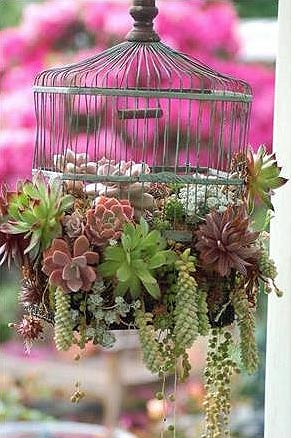 |
The potting mix you use for succulents (those grown in containers outdoors in spring, summer and fall as well as those grown as houseplants) is crucial. Your standard, peat moss-based, organic potting mix sold as being perfect for vegetables and/or annuals in outdoor containers is not quite right for succulents. Look for a potting mix designed specifically for cacti and succulents, as it is going to contain plenty of organic material that holds water, but will be designed to drain more readily than the standard potting blends. Or, buy a good quality, peat moss-based potting mix, and in a large pail or wheelbarrow, mix in around fifteen- to twenty-percent perlite or sharp sand, to aid drainage.
Uses in the Garden
Some succulents, such as Yucca, can hold their own amidst more traditional herbaceous perennials. Often, however, it’s best to create a portion of the garden/landscape bed that has been transitioned into a succulent garden, just as one would create and feature an alpine/rock garden. (Come to think of it, succulents work fabulously in rock gardens.)
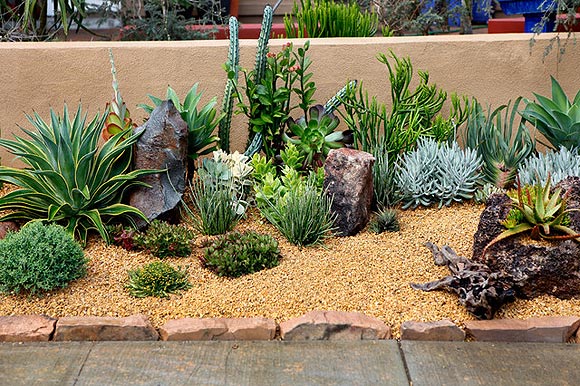 |
| Gardeners in the Southwest have known about succulents for generations. |
You’re going to want a sunny spot, although in super-hot and dry zones 9 & 10, some succulents that aren’t cacti will appreciate a break from intense midday sun.
Soil is key. Clay soils, forget about it, you need to raise the bed or work in copious amounts of organic matter, plus one cubic foot of perlite and one cubic foot of volcanic rock or pea gravel for every 32 cubic feet of garden bed (8’ x 4’). Even a good, dark mineral soil with a five-percent or better organic content is going to need some amending to create proper drainage. Tell you what – search “Garden Soil for Succulents” on the Internet to save both of us some time. The first page of articles all look pretty good.
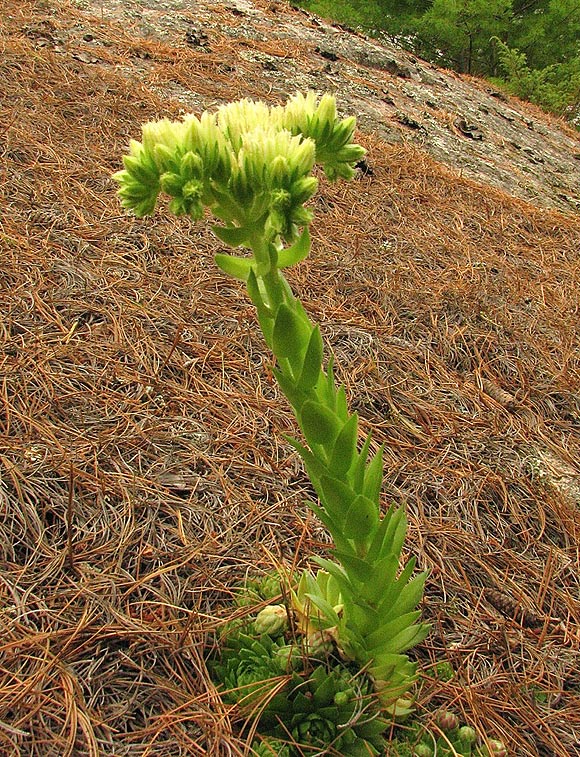 |
| I took this photo of Sempervivum (hens and chicks) in bloom in the wild, Northwest Ontario, every bit of zone 3. |
As Houseplants
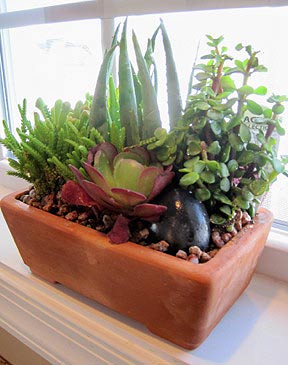 Succulents make terrific houseplants and can be grown individually or in combination of varieties within one container or hanging basket. You’ll want to grow succulents in bright light, typically your south-facing windows. Unlike some tropical houseplants, warm winter temperatures in the home are not required. A sunny, drafty room that doesn’t get very warm in winter is going to be a great location for succulents. Plants go dormant in winter, but remain stoically attractive. In summer, plants easily handle both the sunny windows and elevated temperatures of any room in the house that provides good sunlight exposure.
Succulents make terrific houseplants and can be grown individually or in combination of varieties within one container or hanging basket. You’ll want to grow succulents in bright light, typically your south-facing windows. Unlike some tropical houseplants, warm winter temperatures in the home are not required. A sunny, drafty room that doesn’t get very warm in winter is going to be a great location for succulents. Plants go dormant in winter, but remain stoically attractive. In summer, plants easily handle both the sunny windows and elevated temperatures of any room in the house that provides good sunlight exposure.
Water succulents regularly in spring and summer. It will depend on temperature and level of sunlight, but a good rule of thumb is to water heartily, then let the soil in the container dry out down to one-quarter of an inch from the surface before watering again. If plants become soft, droopy, and begin to lose color (turning yellow to white), you are overwatering. Underwatered plants stop growing, develop small brown spots on leaves, and/or begin dropping leaves.
Fertilize houseplant succulents at the same general rate you do other blooming summer houseplants, around every two weeks if using water soluble fertilizer, once a month if using granular. Do not fertilize after November 1. Resume fertilization in spring, particularly if you notice the plant gaining color and breaking out of dormancy.
Popular Succulent Plants
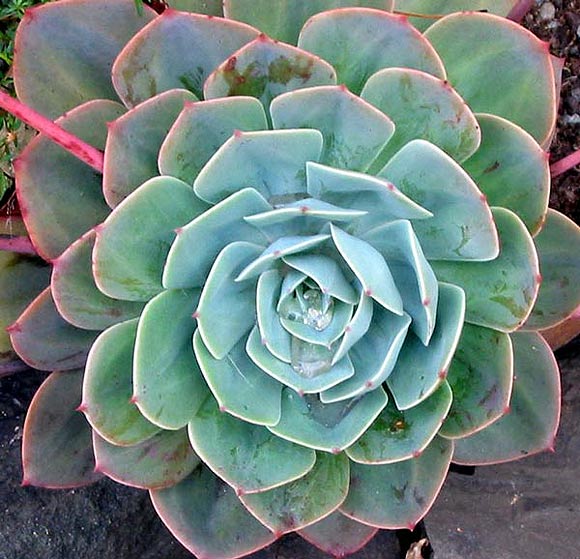 |
| Sempervivum rosularia |
What makes succulents so sexy is their fabulous form. You’re not growing some spindly stemmed, tiny green-leaved, frilly flowered annual or traditional perennial (although Sedums, both upright and stonecrop, are succulents).
You’re going to find a very large number of succulent plants to choose from at your good local nurseries, as well as through online, mail-order nurseries. Here’s a starting point:
- Sempervivum – Among the most popular, hellacious in containers.
- Rosularia – Wonderful in mixed succulent containers as well as at home in the rock garden.
- Orostachys – Wary of overwatering but among the most cold-hardy succulents.
- Echiveria – Fabulous in containers.
- Aloe – Includes varieties of upright, larger plants.
- Crassula – Most popular is Crassula ovata, or jade plant.
- Haworthia – H. attenuate features fleshy, sword-like, variegated leaves.
- Agave – Popular in landscapes in southern California, where plants can reach 6” tall.
- Euphorbia – Euphorbia lactea features an assortment of weird and odd-shaped plants.
- Yucca – Terrific foliage plant, useful in the garden, includes Zone 4 variety Y. filamentosa.
Google any of the above to explore photos and pick your favorites, keeping in mind the above is a relatively short list. Between your local nurseries and the many good mail-order nurseries, you’ll get sucked into succulents to your heart’s content.
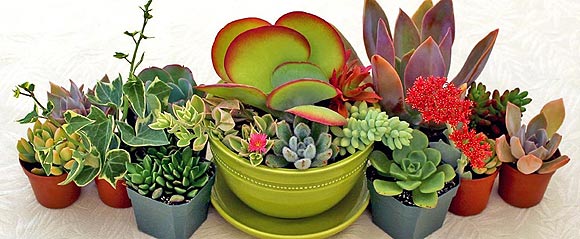
Don Engebretson
The Renegade Gardener